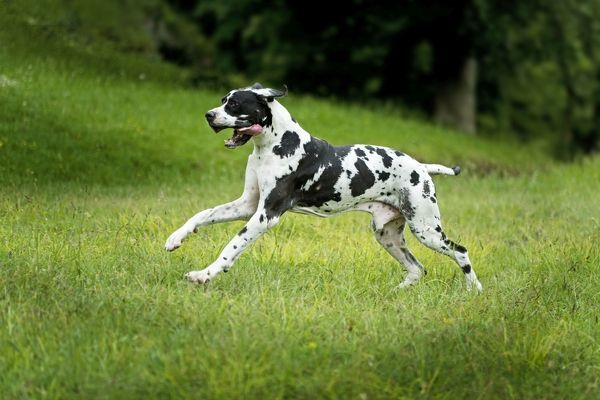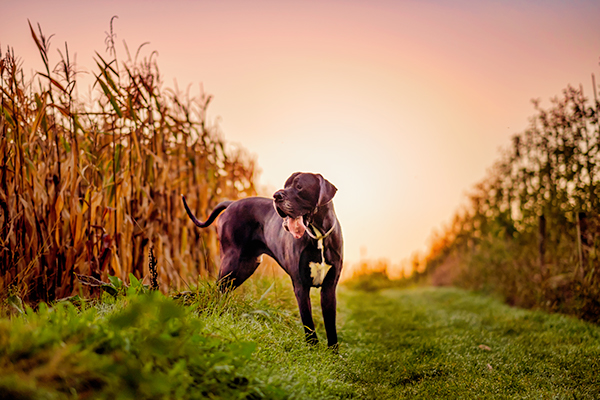
Their origin is a mystery. Ironically, it has nothing to do with Denmark.
Where did this dog come from? Some dog experts point to images of a dog that closely resembles the Great Dane, that for centuries have appeared on ancient Egyptian, Greek and Chinese art and coins. Some claim they originated in Germany, by cross breeding German Mastiffs and either Irish Wolfhounds or Irish Greyhounds. A few, believe they originated in Wales.
What we do know is, the ancestors of the friendly, affectionate, amiable, intelligent, and patient people-pleaser we have in our hearts and homes today, is a far cry from the aggressive, ferocious, fearless hunter of boars, bears and wolves their forbearers were.
For centuries they worked as hunter, trackers, carters and guard dogs. About two hundred years ago, German breeders were successful with evolving the brutal breed from a bold work animal, into a kind, loyal house pet; that will still if called upon, instinctively protect those they love.
Due to their history, they are in the Working group.
This is not a dog recommended for an inexperienced owner. Their sheer size is overwhelming. A Great Dane can tip the scale between 120 and 200 pounds. Combine their weight, with the fact when standing on their hind legs, they will tower over you; there is no question they are a lot of dog to control. Records have been broken by Great Danes standing over 7 feet tall!
As they are intelligent, easy to train and willing to learn, it is crucial to enroll them in positive reinforcement, punishment-free Puppy Kindergarten and socialization groups as early as possible. It is much easier to control and train a 40-pound puppy, than a 150-pound dog! Get them trained and continue to train them as soon and as much as possible. Challenge them mentally, not physically! They are quick to learn and they thrive on the attention they receive when being trained.
Before going any further, because of the numerous health issues Great Danes are inherently predisposed to, it cannot be stressed enough to take care from whom you purchase your pet from. Do not purchase your puppy online, from classified ads, flea markets or pet shops, without thoroughly investigating the breeder. Most are concerned with nothing more than making as much money as possible, at the expense of their breeding pair. Sloppy breeding will cause heartbreak.
Also, the most common and recognized for show colors for Great Danes are: black, fawn, blue, brindle, mantle and harlequin. Do not be fooled by those advertising unusual colors or color combinations as "rare." It is nothing more than extortion! Avoid white or predominately white puppies or dogs. They are more prone to being blind, deaf or both.
Because of the known joint and bone problems associated with giant breeds, insist on Orthopedic Foundation For Animals (OFA) certification. There is no guarantee your dog will not develop elbow and hip dysplasia, hypothyroidism, or Von Willebrand's Disease (VWD). However, certification does show the breeder has pride in and has assumed responsibility for producing the healthiest puppies they can.
Other health problems common to this gentle giant are: Gastric Dialation-Volvus (GDV - also known as bloat), arthritis, bone cancer, Cardiomyopathy (enlarged heart) and Congenital Heart Disease.
Common to giant breeds, the metabolism of the Great Dane is slower than other dogs. This can lead to obesity if overfed and under exercised. Take care not to stress their developing bones, with excessive or strenuous exercise such as jogging, while they are under the age of 18 months. Most dependable breeders will suggest you do not have your Great Dane accompany you on your daily jogs until they are 2 years old.
The average lifespan of a Great Dane is 7 -10 years.
With their friendly, easygoing, rather silly nature, they are usually wonderful with children. Most are remarkably patient, but don't take chances. Never leave them together unsupervised. Because of their immense size and their tendency to lean on people, vigilance is a must around children and older people. They can knock them over like bowling pins without knowing or trying.
Be aware even though they do usually get along well with other and smaller animals, again, because of their size, they must be supervised. Some Great Dane owners have noted, if you are determined to have more than one, a male and a female are probably a wiser choice than a same-sex pair under one roof.
Surprisingly and gratefully, they are easier to housetrain than many breeds! Be fair, firm and consistent and they will get the message quicker than most dogs.
To some, their size and proud body stance does makes them appear unapproachable. Most seem almost intuitive when properly obedience trained, just when they need to step up to the plate as watch or guard dog.
Never, ever, encourage them to jump on you! It is a hard habit to break! Be consistent that the law of the land is all four paws are to remain on the ground at all times. There are NO EXCEPTIONS!
Nicknamed "The Lap Dog," they are clueless about their humongous size and some persistently would like nothing more than to sit on your lap! To avoid confusion and inappropriate behaviors, do not encourage it.
Do not allow your dog on the bed! Provide comfortable sleeping arrangements for them, and stick to it! Usually, the greatest complaint trainers receive from owners of Great Danes; they won't get off the bed! Get down on the floor to snuggle or play with them...never let them up on any bed!
This behemoth does need plenty of exercise. Ninety minutes a day for puppies and at least an hour a day for adults will help make them a bit more manageable in the house. Do not feed your Great Dane immediately before or after exercising them. Also limit their access to water before and after exercise. There is no exact proof, but it is believed it will help to avert bloat.
Walk and talk to your gentle giant. Two long walks in the cool of the day, will help exercise, create a bond and maintain your status as the leader of their pack. Avoid extremes in temperatures! Great Danes do not do well in extreme heat or cold. It's not unusual to see one wearing a sweater in the winter. They are not outside dogs! As much as they enjoy a fenced in backyard to explore now and then, they would much rather be at your side or curled up by your feet.
Basic grooming is a breeze. Rub a damp cloth over them; give them a quick brushing with a soft brush and you're done. A wise Great Dane owner will desensitize their puppy to baths as soon as possible, because it makes life easier later on. Wrestling a 150-pound pooch into the tub isn't effortless! You may prefer to have them professionally groomed a few times a year. Check around for a groomer who is willing to take on a Great Dane. It necessitates a lift, to get them into the tub, which some groomers don't have.
One thing to keep in mind, is keeping a few "shlub" towels nearby. Great Danes are not known to be the neatest eaters and drinkers. Keeping a "shlub" towel handy will help keep them from using you or the furniture as a napkin, drooling on the floor, or throwing "slingers" on the wall. Maintain your sense of humor, when you are dressed in your best dress or suit and they get to you before you get to the "shlub" towel. Remember, they love you!
An interesting little known fact about them is, the Commonwealth of Pennsylvania loves them so much, they have proclaimed the Great Dane as their state dog!
Bottom line: Do your homework! Make sure you know just what you are looking for in a pet before getting your Great Dane. Remember, the size of this dog will have a lot to do with how well they will fit into your specific situation. Stay away from classifieds, flea market backyard breeders and puppy mill stocked pet stores. Do not get taken in by ads for "rare" colored Great Danes. You are being extorted! You may have to pay a little more, but find a reputable, trustworthy breeder. Also check with local shelters and rescues. Many are surrendered for nothing more than financial or health problems of their previous owner. Your new best friend may be patiently waiting there for you. Find out best Great Danes beds by clicking on Great Dane Dog Beds Reviewed on DogBedZone.

